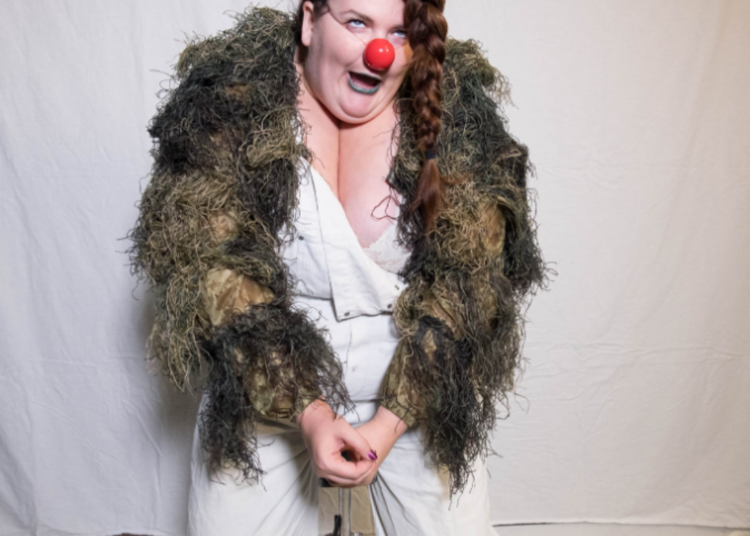A middle-aged woman with wild, dark hair and angular cheekbones bursts onto the Funny Women Twitch stream, a cardboard box around her neck. ‘Aren’t we all feeling a bit boxed in?’ she says with a wink.
Over the next half hour, she mugs, pouts and cracks jokes to the camera while applying thick stripes of mauve and blue paint to her face. Menopause, her lockdown belly – which she produces and wiggles gleefully for the camera – and vaginal lubrication all feature in her breathless monologue. Finally, she crowns herself with a colander stuffed with plastic snakes and declares herself Sedusa, Gorgon clown queen. ‘I do like to petrify some men.’
In real life, this seductive, grotesque character is Maggie Irving, an Exeter-based drama teacher, mum-of-two, and holder of the world’s first PhD in female clowns. Discovering clowning in her 40s after divorcing her husband, she tells me later, felt like ‘a release, like an uncaged bird’.

Irving is one of the many women of all ages who have been drawn to the art of clowning in recent years. Banish images of circus clowns, children’s entertainers or Stephen King’s It from your mind. Although they draw from the same centuries-old traditions, today’s clowns blend cabaret, contemporary theatre, stand-up and a sprinkling of improv – but with a distinct flavour of absurd humour and a childlike sense of freedom. Costumes, although often flamboyant, are less important than a joyful, silly attitude and an ability to roll with the punches.
It doesn’t sound inherently gendered, but the clown scene has long been dominated by men. Figures like Charlie Chaplin, Joseph Grimaldi, Tommy Cooper and Laurel and Hardy shaped popular perception of clowns and achieved fame far beyond their female equivalents. That straight, white, male norm is something that needs to change, according to Irving and many other women, who are working on finding more inclusive ways of performing and teaching clown (as its devotees call it).
Izzy Stott, age twenty-seven, a Glasgow-based comedian who runs women-only clown workshops called Silly Bitch (tagline: ‘you can be a powerful woman and a beautiful idiot’) is one of them.
‘The thing that makes your clown [performance] is the thing that other people will laugh at you for behind your back,’ she says. A clown act should bring out the performer’s true identity without shame, ‘because clowns are never ashamed – they are literal idiots. It’s about finding that inner child.’
Meaghan Morris, age twenty-eight, has used clowning to overcome social shaming of her ‘fat, queer’ body. By day, she is a charity grant administrator, but by night she performs as Melbo the Clown.
Using her body to make people laugh puts her back in control, she says: ‘As a bigger woman, it’s helped me figure out how to move my body and take up space in a world that’s constantly telling me to be smaller… With clown, I’m able to make these huge movements and accentuate the bigness of my body.’
She recalls the liberating feeling of her first clown class. The teacher refused to speak to the students, instead, music repeatedly played on a boombox until they realised, they should start dancing. ‘It’s about not thinking about how you may look, just acting on instinct.’
Lucy Hopkins, age forty-two, is one of the UK’s best-known female clowns, performing ceremonial, occult-themed comedy shows as the ‘High Priestess of Idiot’. In clowning, she found a way to express herself outside of traditional theatre, where she struggled to fit into conventional roles: ‘I was never going to be Juliet. I was always too weird.’
Taking up space has been a theme in her practise, too. ‘The world still often wants women to exist in a very prescriptive way,’ she tells me, flinging her arms around to underscore her point. ‘There’s a lot of pressure on women to look a certain way and appear a certain way… But actually, that pressure is from nowhere interesting. No one interesting is saying, “I wish you’d be pretty and quiet”.’
Irving agrees clowning can be a powerful way for women to subvert social expectations. As a mature student at university, her first clown performance involved tottering around stage in bright red lipstick, big hair and heels, asking her twenty-something classmates if they fancied her. It was liberating to act out the stereotype of the desperate, newly-divorced older woman, she says: as soon as people are laughing, you’re in control. ‘How empowering is that?’
Eve Biard, age twenty-five, started to clown three years ago, after being encouraged by a friend. She tells me it dramatically improved her confidence and anxiety. She’s no longer afraid to look silly in social situations – and why would she, after performing an act where she dressed as a Christmas tree, was carried onstage in a pot and demanded the audience decorate her? Another time, she conducted a reverse striptease: starting out in her underwear, she seductively donned layer after layer of clothing.
Clown has also improved her flirting because she can be more open with people without being ‘terrified’, she says. ‘I now trust that I am funny.’
That fear of not being funny can be a big barrier for women taking up clowning. Biard says: ‘Quite often, when guys come in new to clowning, they treat it like I see them treating improv, which is: “I have to be the funniest. This is a competition. I’m funnier than everyone here, and I know everything.” So they tend to be really bad.’
The confidence imbalance isn’t helped by the traditional style of clown education. Modern clowning was largely developed in the 60s by two French men, Philippe Gaulier and Jacques Lecoq. Lecoq died in 1999, but Gaulier still trains hundreds of clowns every year in a notoriously difficult regime (past pupils include Sacha Baron Cohen, who called him ‘the funniest man I’ve ever met’).
One of Gaulier’s core tenets is that students must ‘find their clown’ through repeated negative criticism. Instead of specific feedback, budding clowns are told they are boring, stupid and hideously unfunny. ‘He’s really nasty to you, he tells you you’re crap all the time… Overcoming that and taking it lightly is part of the process,’ says Stott, who spent a year training at Gaulier’s Parisian École.
Unsurprisingly, the approach has a darker edge, particularly when it is copied by less-experienced teachers. Hopkins compares it to the pickup artist technique of ‘negging’ and says it works well for some but inhibits others: ‘If you’re a white man, then someone telling you you’re a piece of shit might be good for you, because you’re not getting that message in society. But if you’re anyone other than a white man, you’re always getting that message.’
Jon Davison, founder of London Clown School, agrees: ‘It’s something a lot of people now are questioning… For a straight white male who goes out the door after [a class] having shown his vulnerability, what’s going to happen to him? Nothing.’
His own classes, which are now attended mostly by women, avoid harsh criticism, instead using ‘laughter response’ techniques which focus on positive reinforcement – if people are laughing, then you’re being funny. Irving’s classes likewise focus on drawing students out of their shell in a positive atmosphere.
How might this look? Hopkins tells me of a performance where she invited a man and woman from the audience to present an offering on stage. While the woman was shy, the man was assured and dominated the scene. Finally, Hopkins told the man to lie down on the floor. Then she turned to the woman and said: ‘Roll him off to the side.’ He rolled away and the audience roared with laughter.
Hopkins cackles. ‘In that moment, it felt like we women had pushed away the man to just take a little bit more space.’














